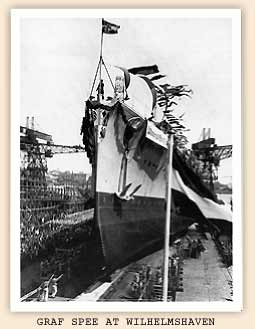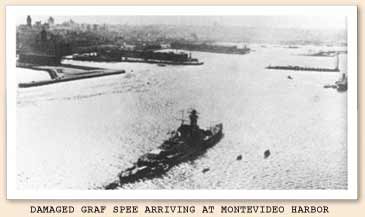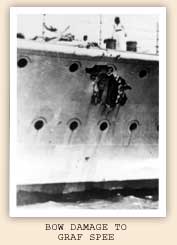|
 |
|
|
|
|
|
|
|
 |
|
|
|
|
|
|
|
|
|
|
 |
|
|
 |
|
| On January 6th, 1936 the last of three unusual battleships was commissioned at the Kiel Navy Yards in Germany and took her rightful place of honor among the expanding German fleet. |
|
 |
|
|
|
|
The Admiral Graf Spee was built to be faster than a conventional battleship but still larger and more powerful than a cruiser. Some naval experts refer to her as a "battle cruiser", but she is more often described as a "pocket battleship". Her main armament consisted of six 11 inch guns and eight 5.5 inch guns.
The architect of the German fleet was Grand Admiral Erich Raeder, a brilliant naval planner. As the build-up to war began, Admiral Raeder planned to have ships at hand that could interrupt British and French commerce moving through the Atlantic. To do this he needed several fast and very threatening ships that could hunt for enemy merchant vessels in the open seas and sink them. The Pocket Battleships were Admiral Raeder's answer to this need.
In August of 1939 the Graf Spee left her home port at Wilhelmshaven, Germany under command of Captain Hans Langsdorff. Her orders were to head into the Atlantic, moving slowly southward, and await further instructions.
|
|
|
 |
|
|
|
|
 |
|
Just a few weeks later, Germany invaded Poland and the war was on. Shortly after, Langsdorff received his mission, to hunt down enemy merchant vessels in the South Atlantic and sink them. This process would create a shortage of needed items such as gasoline, rubber, metals, grain and even beef that came to Britain and France from Africa and the Americas.
|
|
|
 |
|
|
On September 30, the Graf Spee met with her first encounter, the 5,000 ton British steamer, Clement. Langsdorff launched the Graf Spee’s Arado float plane which halted the Clement with cannon fire while the Graf Spee caught up. Next, Langsdorff ordered everyone on board the Clement into lifeboats and notified the Brazilian Coast Guard that the crew needed assistance. Then he sunk the Clement with gunfire and left the scene. No lives were lost.
The Graf Spee continued in this manner sinking nine enemy merchant vessels before mid-December. On December 13th she thought she had another merchant vessel on the horizon. Since the Graf Spee's Arado float plane was out of service, Langsdorff chose to speed the Graf Spee toward his new target.
|
|
|
|
|
|
|
The British Navy developed a battle group, Force G, to try to halt the destruction in the South Atlantic. Force G was under command of Admiral Heywood and consisted this day of one heavy cruiser, Exeter, and two light cruisers, Ajax and Achilles. It was this battle group that Langsdorff was now mistakenly racing toward.
By traditional criterion, the odds favored Graf Spee in the battle that was about to ensue. Langsdorff could hurl some 4,700lbs of shells in one salvo, compared with Force G’s combined total of about 3,100lbs. The Graf Spee’s guns also outdistanced her enemy’s, but in the end this did not matter as Langsdorff quickly closed the distance by mistakenly racing toward his enemy.
In the night long battle that followed, serious damage was done to all ships. The Exeter was principally knocked out of Service. The Graf Spee sustained heavy damage and had 59 wounded and 39 dead. Langsdorff contacted Admiral Raeder and they decided he would head into the nearest neutral port.
|
|
|
 |
|
|
|
Captain Langsdorff told Admiral Raeder that there were three options left for the Graf Spee. He could, try to fight his way to Argentina, a much friendlier nation, or he could accept internment in Montevideo or he could scuttle his ship. The reply came back from Germany that Langsdorff was not to allow his ship to remain in Montevideo because the British spies would easily get on board the interned Graf Spee and learn Germany’s naval secrets. Whichever of the remaining options Langsdorff would choose were up to him.
|
|
 |
|
|
|
 |
|
 |
|
Langsdorff felt…and others agreed, that the British force outside Montevideo was growing. His chances of getting past this force seemed unlikely. On December 17th Langsdorff had become angry at the poor reception he and his crew had been given in Uruguay. He secured a tug to take his crew to a more hospitable environment in Buenos Aires and then took a skeleton crew onboard the Graf Spee and sailed her out of Montevideo Harbor. Stopping short, just a few miles from the harbor, he then had his crew scuttle their ship to the amazement of the Uruguayan onlookers.
|
|
|
|
 |
|
|
As the sun set the Graf Spee exploded and smoked and pitched and finally settled to the shallow bottom where she has been since.
Captain Langsdorff settled into his new quarters in Buenos Aires and was found the next morning, dead of a gun shot to the head and a revolver in his own hand.
|
|
|
 |
|
|
 |
|
|
|
If you would like to read more about the Graff Spee and The Battle of The River Plate please check the following books:
The Battle of the River Plate
by Dudley Pope
published by William Kimber, London
1956
Lost Ships
by Mensun Bound
published by Simon & Schuster
1998
|
|
|
|
 |
|
|
|
 |
|
 |
|
 |
|
 |
|
|
PLEASE DO NOT USE IMAGES OR TEXT FROM THIS WEBSITE WITHOUT WRITTEN PERMISSION
|
|
 |
|
|
|
|
|
|
|
|
|
|
|
|
|
|
|
|
|
|
|
|
|
|
|
|
|
|
|